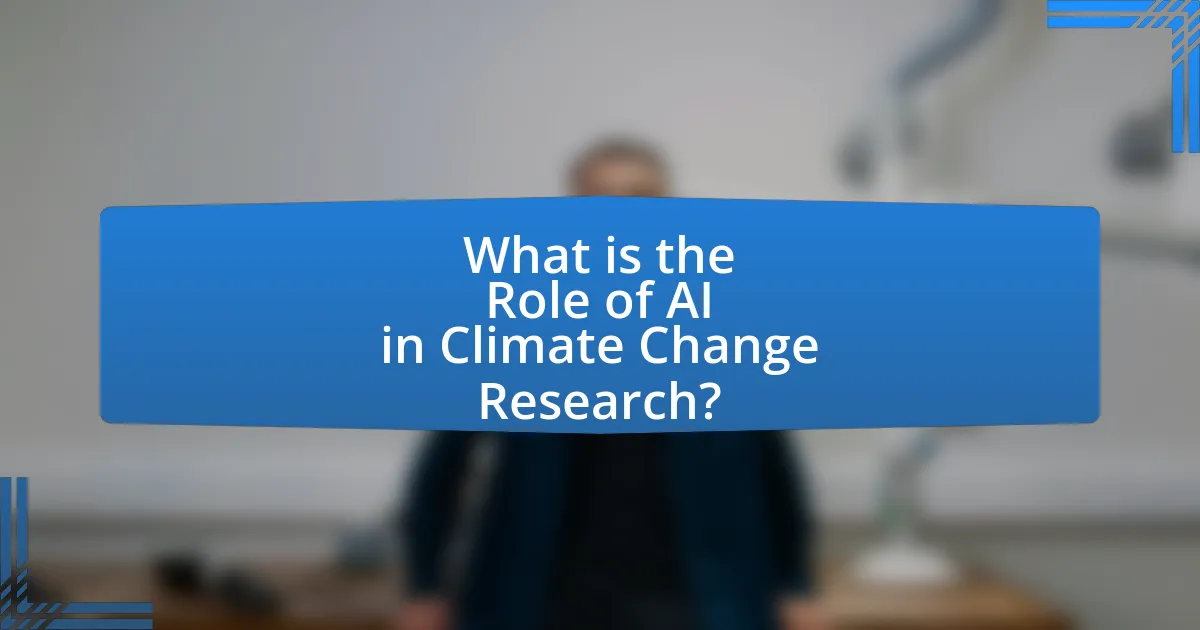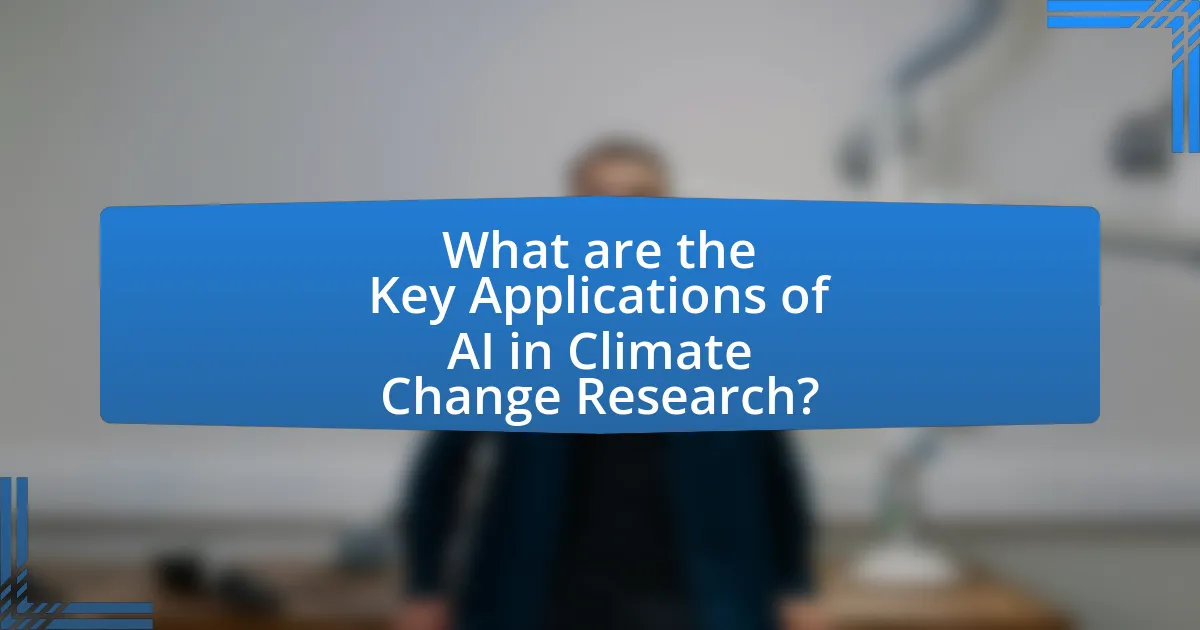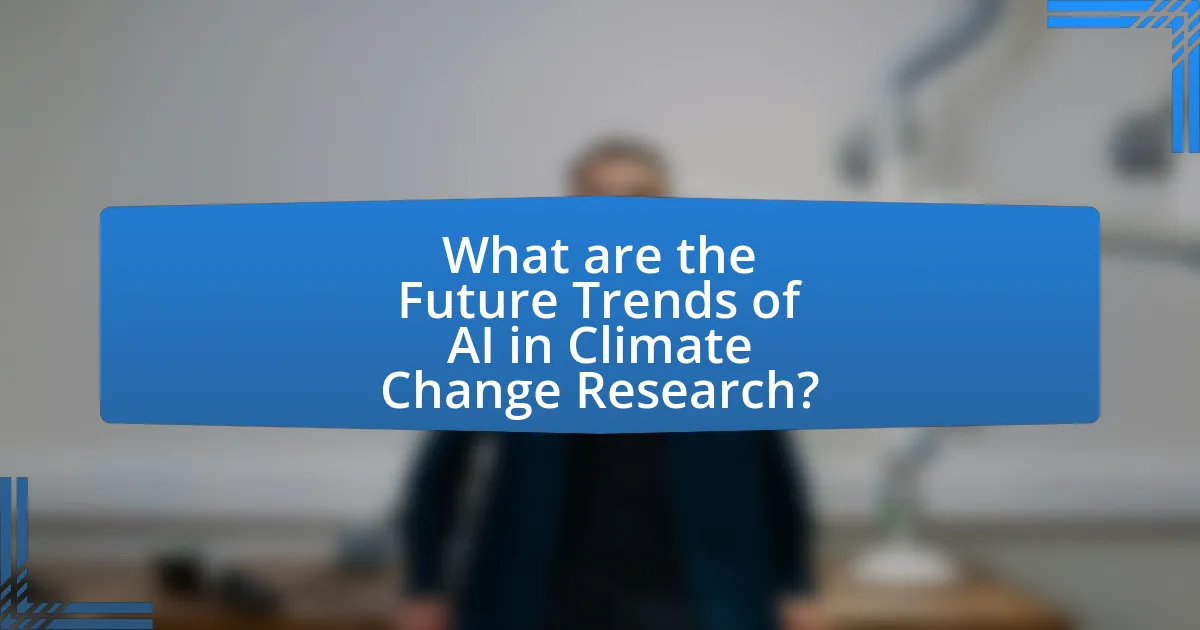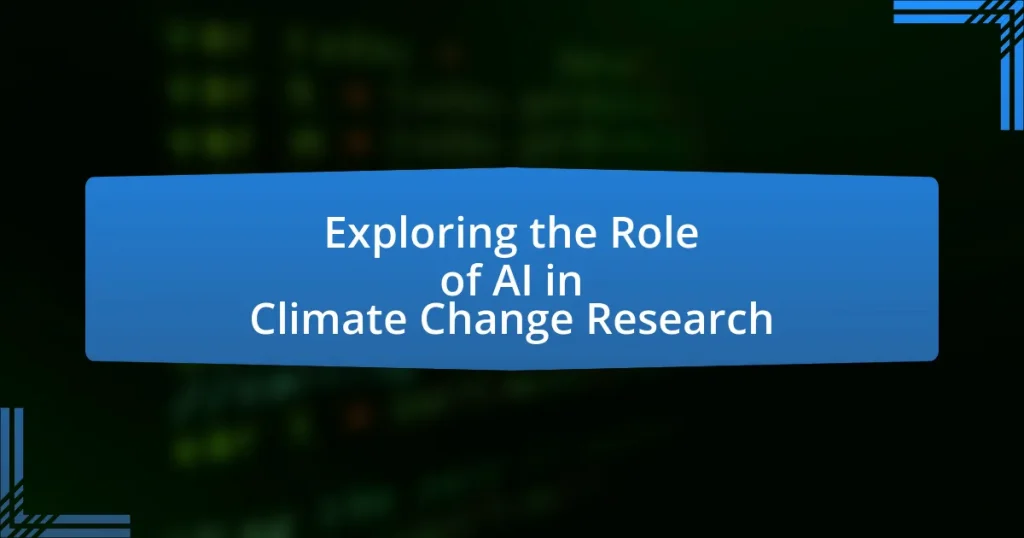The article explores the critical role of artificial intelligence (AI) in climate change research, highlighting its applications in data analysis, predictive modeling, and climate monitoring. AI technologies, including machine learning and computer vision, enhance the accuracy of climate models and facilitate real-time monitoring of environmental changes. The article discusses specific AI applications, such as improving climate forecasts, optimizing resource management, and aiding in climate mitigation strategies. Additionally, it addresses the ethical considerations and best practices for responsible AI usage in climate research, emphasizing the importance of transparency and interdisciplinary collaboration.

What is the Role of AI in Climate Change Research?
AI plays a crucial role in climate change research by enhancing data analysis, modeling, and prediction capabilities. It enables researchers to process vast amounts of environmental data, identify patterns, and simulate climate scenarios with greater accuracy. For instance, AI algorithms can analyze satellite imagery to monitor deforestation and track changes in land use, which are critical for understanding carbon emissions. Additionally, machine learning models have been employed to predict extreme weather events, helping communities prepare for climate-related disasters. Studies, such as those published in “Nature Climate Change,” demonstrate that AI can improve climate models by integrating diverse datasets, leading to more reliable forecasts and informed policy decisions.
How is AI currently being utilized in climate change research?
AI is currently utilized in climate change research primarily for data analysis, predictive modeling, and climate monitoring. Researchers employ machine learning algorithms to analyze vast datasets from satellite imagery, climate models, and environmental sensors, enabling them to identify patterns and trends in climate change. For instance, AI techniques have been used to improve the accuracy of climate models by integrating diverse data sources, which enhances predictions of future climate scenarios. Additionally, AI aids in monitoring deforestation and greenhouse gas emissions through image recognition and anomaly detection, providing real-time insights into environmental changes. These applications demonstrate AI’s critical role in advancing our understanding of climate dynamics and informing policy decisions.
What specific AI technologies are being applied in this field?
Specific AI technologies applied in climate change research include machine learning, deep learning, natural language processing, and computer vision. Machine learning algorithms analyze large datasets to identify patterns and predict climate trends, while deep learning enhances the accuracy of climate models through neural networks. Natural language processing is utilized to extract insights from scientific literature and social media, facilitating the understanding of public sentiment and scientific discourse. Computer vision aids in monitoring environmental changes through satellite imagery and remote sensing data. These technologies collectively enhance the ability to model, predict, and respond to climate change impacts effectively.
How do these technologies enhance data analysis in climate science?
Technologies such as artificial intelligence and machine learning enhance data analysis in climate science by enabling the processing of vast datasets quickly and accurately. These technologies can identify patterns and correlations in climate data that traditional methods may overlook, leading to more precise climate modeling and predictions. For instance, AI algorithms can analyze satellite imagery to monitor deforestation and its impact on climate change, providing real-time insights that inform policy decisions. Additionally, machine learning techniques can improve the accuracy of climate forecasts by integrating diverse data sources, such as historical weather patterns and ocean temperatures, thereby enhancing the understanding of climate dynamics.
Why is AI important for addressing climate change?
AI is important for addressing climate change because it enhances data analysis and predictive modeling, enabling more effective climate action. By processing vast amounts of environmental data, AI can identify patterns and trends that inform climate policies and strategies. For instance, AI algorithms have been used to improve climate models, leading to more accurate predictions of climate impacts, as demonstrated in a study published in Nature Climate Change, which showed that AI can increase the accuracy of climate forecasts by up to 30%. Additionally, AI optimizes energy consumption in various sectors, contributing to reduced greenhouse gas emissions.
What challenges in climate research can AI help overcome?
AI can help overcome challenges in climate research such as data analysis, predictive modeling, and climate impact assessment. By processing vast amounts of climate data quickly and accurately, AI algorithms can identify patterns and trends that human researchers may overlook. For instance, AI has been utilized in projects like ClimateNet, which employs machine learning to enhance climate models, improving their predictive capabilities by up to 30%. Additionally, AI can optimize resource allocation for climate adaptation strategies, enabling more effective responses to climate-related disasters. These applications demonstrate AI’s potential to significantly enhance the efficiency and accuracy of climate research efforts.
How does AI improve predictive modeling for climate scenarios?
AI enhances predictive modeling for climate scenarios by utilizing advanced algorithms to analyze vast datasets, leading to more accurate forecasts. These algorithms can identify complex patterns and relationships within climate data that traditional models may overlook. For instance, AI techniques such as machine learning have been shown to improve the accuracy of climate predictions by up to 30% compared to conventional methods, as evidenced by research published in “Nature Climate Change” by Rolnick et al. (2019). This capability allows for better understanding of climate dynamics and more effective planning for climate-related impacts.

What are the Key Applications of AI in Climate Change Research?
Key applications of AI in climate change research include predictive modeling, climate data analysis, and optimization of resource management. Predictive modeling utilizes machine learning algorithms to forecast climate patterns and extreme weather events, enhancing preparedness and response strategies. Climate data analysis employs AI to process vast datasets from satellites and sensors, enabling researchers to identify trends and correlations in climate change indicators. Additionally, AI optimizes resource management by improving energy efficiency and reducing waste in various sectors, such as agriculture and transportation. These applications are supported by studies demonstrating AI’s effectiveness in analyzing complex climate systems and improving decision-making processes, such as the research published in “Nature Climate Change,” which highlights AI’s role in enhancing climate resilience.
How does AI contribute to climate data collection and analysis?
AI significantly enhances climate data collection and analysis by automating data processing and improving predictive modeling. Machine learning algorithms can analyze vast datasets from satellites, sensors, and climate models, identifying patterns and trends that human analysts might overlook. For instance, AI techniques have been used to process satellite imagery, enabling more accurate assessments of deforestation rates and urban heat islands. According to a study published in Nature Communications, AI can increase the accuracy of climate predictions by up to 30% compared to traditional methods. This capability allows researchers to make more informed decisions regarding climate policies and mitigation strategies.
What methods are used for data gathering through AI?
Data gathering through AI primarily utilizes methods such as machine learning, natural language processing, and computer vision. Machine learning algorithms analyze large datasets to identify patterns and make predictions, which is essential for climate modeling. Natural language processing enables the extraction of relevant information from unstructured data sources like research papers and social media, facilitating the understanding of public sentiment and scientific discourse on climate change. Computer vision techniques process satellite imagery and remote sensing data to monitor environmental changes, such as deforestation and ice melt. These methods collectively enhance the accuracy and efficiency of data collection in climate change research.
How does AI facilitate the interpretation of complex climate data?
AI facilitates the interpretation of complex climate data by employing advanced algorithms and machine learning techniques to analyze vast datasets efficiently. These technologies can identify patterns, correlations, and anomalies within climate data that would be challenging for humans to discern. For instance, AI models can process satellite imagery and climate simulations to predict weather patterns and climate changes with greater accuracy. Research published in “Nature Climate Change” by Rolnick et al. (2019) highlights that AI can enhance climate modeling by integrating diverse data sources, leading to improved forecasting and better-informed decision-making in climate policy.
What role does AI play in climate change mitigation strategies?
AI plays a crucial role in climate change mitigation strategies by enhancing data analysis, optimizing resource management, and improving predictive modeling. For instance, AI algorithms can analyze vast datasets from climate models, satellite imagery, and sensor networks to identify patterns and trends in climate change, enabling more informed decision-making. Additionally, AI-driven tools can optimize energy consumption in buildings and transportation systems, significantly reducing greenhouse gas emissions. Research from the International Energy Agency indicates that AI applications in energy efficiency could lead to a reduction of up to 10% in global energy demand by 2030. Furthermore, AI enhances climate modeling accuracy, allowing for better predictions of climate impacts, which is essential for developing effective mitigation strategies.
How can AI optimize renewable energy systems?
AI can optimize renewable energy systems by enhancing energy management, improving predictive maintenance, and facilitating grid integration. For instance, AI algorithms analyze vast datasets from renewable sources, such as solar and wind, to forecast energy production more accurately, which helps in balancing supply and demand. According to a study by the International Renewable Energy Agency, AI can increase the efficiency of renewable energy systems by up to 30% through better resource allocation and operational strategies. Additionally, AI-driven predictive maintenance reduces downtime by identifying potential equipment failures before they occur, thereby ensuring continuous energy supply.
What impact does AI have on carbon footprint reduction initiatives?
AI significantly enhances carbon footprint reduction initiatives by optimizing energy consumption and improving resource management. For instance, AI algorithms analyze data from smart grids to predict energy demand, enabling more efficient energy distribution and reducing waste. According to a report by the International Energy Agency, AI applications in energy efficiency could lead to a reduction of up to 10% in global energy consumption by 2030. Additionally, AI-driven analytics in transportation can optimize routes, reducing fuel consumption and emissions. These applications demonstrate AI’s critical role in facilitating effective strategies for lowering carbon footprints across various sectors.

What are the Future Trends of AI in Climate Change Research?
Future trends of AI in climate change research include enhanced predictive modeling, improved data analysis, and the integration of AI with remote sensing technologies. Enhanced predictive modeling will allow researchers to simulate climate scenarios with greater accuracy, utilizing machine learning algorithms to analyze vast datasets from climate models and historical climate data. Improved data analysis will enable the extraction of actionable insights from complex datasets, facilitating better decision-making for climate policies. The integration of AI with remote sensing technologies, such as satellite imagery, will provide real-time monitoring of environmental changes, allowing for timely interventions. These trends are supported by advancements in AI techniques, such as deep learning, which have shown significant improvements in pattern recognition and data interpretation, as evidenced by studies like “Deep Learning for Climate Science” published in Nature Communications.
How is AI expected to evolve in the context of climate research?
AI is expected to evolve in climate research by enhancing predictive modeling, improving data analysis, and facilitating real-time monitoring of environmental changes. As climate data becomes increasingly complex, AI algorithms will leverage machine learning techniques to analyze vast datasets, identify patterns, and generate more accurate climate models. For instance, a study published in Nature Climate Change in 2021 demonstrated that AI could improve climate predictions by up to 30% compared to traditional methods. Additionally, AI will enable the integration of diverse data sources, such as satellite imagery and sensor data, allowing for more comprehensive assessments of climate impacts. This evolution will ultimately lead to more effective climate mitigation and adaptation strategies.
What emerging technologies could enhance AI’s role in this field?
Emerging technologies such as quantum computing, edge computing, and advanced sensor networks could significantly enhance AI’s role in climate change research. Quantum computing offers the potential to process vast datasets and complex simulations at unprecedented speeds, enabling more accurate climate modeling. Edge computing allows for real-time data processing closer to the source, which is crucial for monitoring environmental changes and making timely decisions. Advanced sensor networks provide high-resolution data on climate variables, improving the training and effectiveness of AI algorithms. These technologies collectively empower AI to analyze and predict climate patterns more effectively, leading to better-informed strategies for mitigation and adaptation.
How might AI influence policy-making related to climate change?
AI can significantly influence policy-making related to climate change by providing data-driven insights and predictive analytics that enhance decision-making processes. For instance, AI algorithms can analyze vast datasets to identify trends in climate patterns, enabling policymakers to understand the potential impacts of climate change more accurately. A study by the World Economic Forum in 2021 highlighted that AI can improve climate modeling and forecasting, which helps governments create more effective climate policies. Additionally, AI can optimize resource allocation for climate initiatives, ensuring that funds are directed toward the most impactful projects. This capability is supported by research from the International Energy Agency, which found that AI applications in energy management can lead to a 10-20% reduction in emissions.
What are the ethical considerations of using AI in climate research?
The ethical considerations of using AI in climate research include data privacy, algorithmic bias, and accountability. Data privacy is crucial as AI systems often require large datasets, which may contain sensitive information about individuals or communities. Algorithmic bias can lead to skewed results, potentially exacerbating existing inequalities in climate impact and resource distribution. Accountability is essential to ensure that AI-driven decisions are transparent and that researchers are responsible for the outcomes of their models. For instance, a study by the AI for Earth program highlights the importance of ethical frameworks in guiding AI applications to avoid unintended consequences in environmental decision-making.
How can researchers ensure responsible AI usage in climate studies?
Researchers can ensure responsible AI usage in climate studies by implementing ethical guidelines and frameworks that prioritize transparency, accountability, and inclusivity. Establishing clear protocols for data collection, model training, and result interpretation helps mitigate biases and enhances the reliability of AI applications. For instance, the AI for Earth initiative by Microsoft emphasizes the importance of ethical AI in environmental research, advocating for diverse datasets and stakeholder engagement to address potential disparities in climate impact assessments. Additionally, adhering to established ethical standards, such as those outlined by the Partnership on AI, can guide researchers in making informed decisions that align with societal values and environmental sustainability.
What frameworks exist to guide ethical AI applications in this domain?
Several frameworks exist to guide ethical AI applications in climate change research, including the AI Ethics Guidelines by the European Commission, the IEEE Global Initiative on Ethics of Autonomous and Intelligent Systems, and the Partnership on AI’s Tenets. The European Commission’s guidelines emphasize transparency, accountability, and fairness in AI systems, which are crucial for climate-related applications. The IEEE initiative focuses on ensuring that AI technologies are aligned with human values and ethical principles, promoting responsible innovation. The Partnership on AI outlines best practices for ethical AI deployment, emphasizing collaboration among stakeholders to address societal challenges, including climate change. These frameworks collectively provide a structured approach to ensure that AI technologies are developed and implemented responsibly in the context of climate research.
What best practices should researchers follow when integrating AI in climate change research?
Researchers should prioritize transparency, data quality, and interdisciplinary collaboration when integrating AI in climate change research. Transparency ensures that AI models and their decision-making processes are understandable and reproducible, which is crucial for building trust in findings. High-quality, diverse datasets are essential for training AI models effectively, as they improve accuracy and reduce biases, leading to more reliable predictions. Interdisciplinary collaboration brings together expertise from climate science, data science, and social sciences, fostering innovative approaches and comprehensive solutions to complex climate issues. These practices are supported by studies indicating that transparent methodologies and robust data significantly enhance the credibility and impact of research outcomes in climate science.


